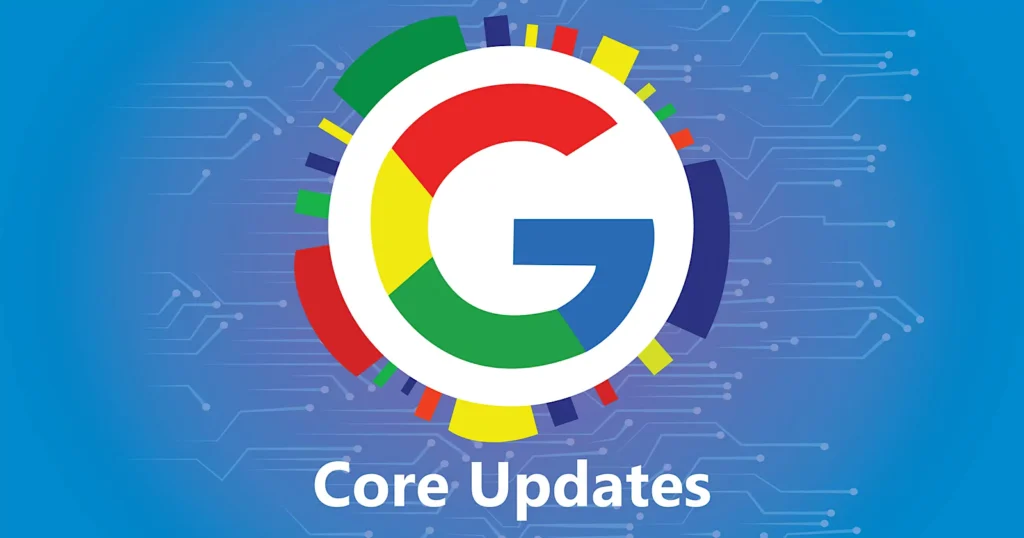You might be surprised to know that nearly 90% of online experiences begin with a search engine, making a website’s ranking on Google crucial to its success. As Google continues to refine its algorithm, core updates can significantly impact your website’s ranking position. These updates can either boost your website’s visibility in search results or lead to a decline in traffic. But what exactly happens to your rankings when a core update is released? Understanding the intricacies of these updates and how they affect your website’s ranking can be the key to staying ahead of the competition.
Key Takeaways
- Google Core Updates refine search algorithm to improve search result quality and relevance, impacting website rankings.
- Updates can improve or worsen website rankings, depending on alignment with existing content and SEO strategies.
- Core updates assess search nuances to provide more accurate results, focusing on content quality, user experience, and technical optimization.
- Websites following best practices for SEO may see a boost in rankings after a core update.
- Focus on creating high-quality content and user experience helps future-proof websites against potential ranking drops from core updates.
Google Core Update Explained
Google’s core updates are a series of periodic changes made to its search algorithm, designed to improve the overall quality and relevance of search results.
You’ll notice that these updates impact your search rankings, as they refine the core algorithm to better match search intent.
When a core update is released, you may see fluctuations in your website’s rankings.
This is because the update is adjusting the search nuances to provide more accurate results.
You’ll need to assess how these changes affect your website and adjust your strategy accordingly.
Understanding the core algorithm and its updates is crucial for maintaining a strong online presence.
The core algorithm is the foundation of Google’s search functionality, and updates to this algorithm can significantly impact your search rankings.
You should focus on creating high-quality content that aligns with the search nuances and intent, as this will help you navigate the core updates more effectively.
How Core Updates Work

When you analyze a Google Core Update, you’ll notice that it assesses the quality of content across the web, evaluating its relevance, accuracy, and overall value to users.
These assessments are made possible by changes to Google’s algorithms, which are designed to improve the way the search engine understands and ranks content.
Assessing Content Quality
A key aspect of how core updates work is assessing content quality, which involves evaluating various signals to determine the relevance, usefulness, and overall value of a webpage. You’ll want to focus on creating high-quality content that resonates with your target audience. To do this, you’ll need to conduct regular content audits to identify areas for improvement.
| Content Quality Metric | Description |
|---|---|
| Relevance | How well does the content match the search query? |
| Authority | Is the content written by an expert or credible source? |
| Depth | Does the content provide a comprehensive overview of the topic? |
| Engagement | Does the content encourage interaction or sharing? |
| Freshness | Is the content up-to-date and relevant to current events? |
Algorithm Changes Impact
Assessing content quality is just one piece of the puzzle when it comes to understanding how core updates work.
To get a complete picture, you need to understand the algorithm changes that occur with each update. Google’s algorithm history is marked by significant updates that have reshaped the search landscape over the years.
When a core update is released, it can impact your rankings in various ways.
The algorithm changes can affect how your content is crawled, indexed, and ranked. This, in turn, can alter the search landscape, making it more or less competitive for your website.
You may notice changes in your search engine results page (SERP) rankings, traffic, and engagement metrics.
To navigate these changes, it’s essential to stay up-to-date with Google’s algorithm history and understand the search landscape.
By doing so, you can adjust your SEO strategies to align with the updated algorithm.
This might involve refining your content, adjusting your link building tactics, or optimizing your website’s technical performance.
Impact on Website Rankings
You’ll likely notice changes in your website’s ranking position after a Google Core Update, as this affects how well your site matches the algorithm’s updated criteria.
You may see your site’s ranking position improve or worsen, depending on whether the updates align with or contradict your existing content and SEO strategies.
Additionally, these updates can also impact your site’s visibility in search results, potentially leading to improved search visibility or reduced traffic.
Ranking Position Changes
Google’s latest Core Update is likely to bring significant ranking position changes, directly impacting your website’s rankings and its online visibility.
You can expect ranking fluctuations, as the update reassesses the relevance and authority of your content. This may result in position volatility, where your website’s rankings fluctuate over time.
The Core Update aims to improve the overall quality of search results, which means that some websites may experience a drop in rankings, while others may see an increase.
This is because the algorithm is now better equipped to understand user intent and identify high-quality content that meets those needs. If your website has been following best practices for SEO, you may see a boost in rankings. However, if your website has been relying on outdated tactics or low-quality content, you may experience a decline.
It’s essential to monitor your website’s rankings closely after the update and adjust your SEO strategy accordingly.
Analyze your website’s performance, identify areas for improvement, and make the necessary changes to maintain or improve your online visibility.
Improved Search Visibility
The latest Core Update’s impact on website rankings can lead to improved search visibility, as the algorithm refines its understanding of relevance and authority.
When you see an increase in your website’s search visibility, it’s likely because the update has identified your content as more relevant to users’ search queries. This can be attributed to the algorithm’s ability to better understand your brand’s expertise and authority in a particular niche.
As your website gains more visibility, you may notice improvements in:
- Brand awareness: Increased visibility can lead to more users recognizing and remembering your brand, which can ultimately drive more traffic and conversions.
- Search authority: The algorithm’s refined understanding of relevance can establish your website as a trusted source in your industry, leading to higher search authority.
- Targeted traffic: Improved search visibility can drive more targeted traffic to your website, as users are more likely to click on relevant results.
- Conversion rates: With more targeted traffic, you may see an increase in conversion rates, as users are more likely to engage with your content and take desired actions.
Key Factors in Rankings
Several key factors contribute to your page’s ranking in search results following a Google Core update. Google evaluates various aspects of your website to determine its relevance and quality, and assigns a ranking position accordingly. Understanding these factors can help you optimize your website for better search visibility.
| Ranking Metrics | Search Signals |
|---|---|
| Page speed | Mobile-friendliness, responsiveness |
| Content quality | Depth, accuracy, relevance, freshness |
| User experience | Bounce rate, time on page, engagement |
| Authority and trust | Domain age, backlinks, SSL encryption |
| Technical optimization | XML sitemap, schema markup, meta tags |
Recovery From Ranking Drops
Following a Google Core update, your website may experience a ranking drop, and recovery can be a challenging process.
Ranking fluctuations are common after these updates, and understanding the reasons behind the drop is crucial to developing effective recovery strategies.
To recover from a ranking drop, you’ll need to analyze your website’s content, structure, and technical aspects.
Here are some key areas to focus on:
- Content quality: Review your website’s content to ensure it’s high-quality, engaging, and relevant to your target audience.
- Technical SEO: Check your website’s technical SEO aspects, such as page speed, mobile responsiveness, and SSL encryption.
- User experience: Evaluate your website’s user experience, including navigation, layout, and content organization.
- Link equity: Analyze your website’s backlink profile to ensure it’s healthy and free from spammy links.
What to Expect After Update

After analyzing and addressing potential issues that led to a ranking drop, you’ll want to know what to expect during the recovery period.
Post analysis, it’s essential to understand that recovery timeframes can vary significantly. Google’s algorithms take time to reassess and reevaluate your website’s content, structure, and overall quality.
During this period, you may notice fluctuations in your rankings. This is normal, as the algorithm continues to refine its assessment of your website.
It’s crucial to be patient and allow the algorithm to complete its reevaluation process. The update timeline can range from a few weeks to several months, depending on the complexity of the issues addressed and the overall quality of your website.
As the algorithm refines its assessment, you may start to notice improvements in your rankings. This can happen gradually, with small increments in visibility and traffic.
It’s essential to monitor your website’s performance closely, using tools like Google Analytics and Search Console to track changes in your rankings and adjust your strategy accordingly.
Strategies for Future Updates
As you navigate the complexities of Google’s Core Updates, it’s essential to develop a long-term strategy to minimize potential disruptions and ensure your website remains competitive.
To achieve this, focus on future-proofing your website by prioritizing high-quality content, user experience, and technical optimization.
Algorithm watching is crucial to staying ahead of the curve.
Keep track of Google’s updates and analyze their impact on your website’s performance. This will help you identify areas for improvement and make data-driven decisions.
To future-proof your website, consider the following strategies:
- Diversify your traffic sources: Don’t rely solely on Google for traffic; explore other channels, such as social media and email marketing.
- Invest in technical SEO: Ensure your website is technically sound, with fast load times, mobile-friendliness, and secure browsing.
- Create high-quality, evergreen content: Focus on producing content that remains relevant and valuable over time.
- Monitor and adapt to algorithm changes: Stay up-to-date with the latest algorithm updates and adjust your strategy accordingly.
FAQs: Google Core Update
Can Google Core Update Affect Local Search Results?
You’ll find that Google’s core updates can indeed impact local search results, reflecting local nuances and geographic factors that influence rankings, making it essential to monitor and adjust your local SEO strategy accordingly.
Are All Websites Impacted by Core Updates Equally?
Imagine a digital playing field, where you’d expect equal treatment for all websites. However, Google’s core updates don’t always level the ground, as algorithm biases can creep in, unfairly impacting certain sites over others.
How Often Does Google Release Core Updates?
You track Google’s frequency of core updates, noting they don’t follow strict schedules. Google releases core updates several times a year, averaging 3-4 major updates, with minor tweaks in between, refining search results.
Do Core Updates Target Specific Industries or Niches?
When analyzing core updates, you’ll notice they don’t target specific industries or niches, but rather, they assess sector analysis and industry scrutiny across the board to improve overall search results and user experience.
Can Website Design Impact Core Update Rankings?
You’ll be surprised to know 75% of users make judgments about a company’s credibility based on its website design. When it comes to core update rankings, your website’s visual elements and mobile responsiveness greatly impact user experience.
Conclusion
You’ve learned how the Google Core Update can significantly impact your website’s rankings. It’s essential to stay adaptable and focus on best SEO practices to minimize potential drops. Interestingly, a study found that 66% of websites experience ranking fluctuations after a Core Update, with 25% seeing significant changes. By prioritizing high-quality content and staying informed, you’ll be better equipped to navigate future updates and maintain a strong online presence.
